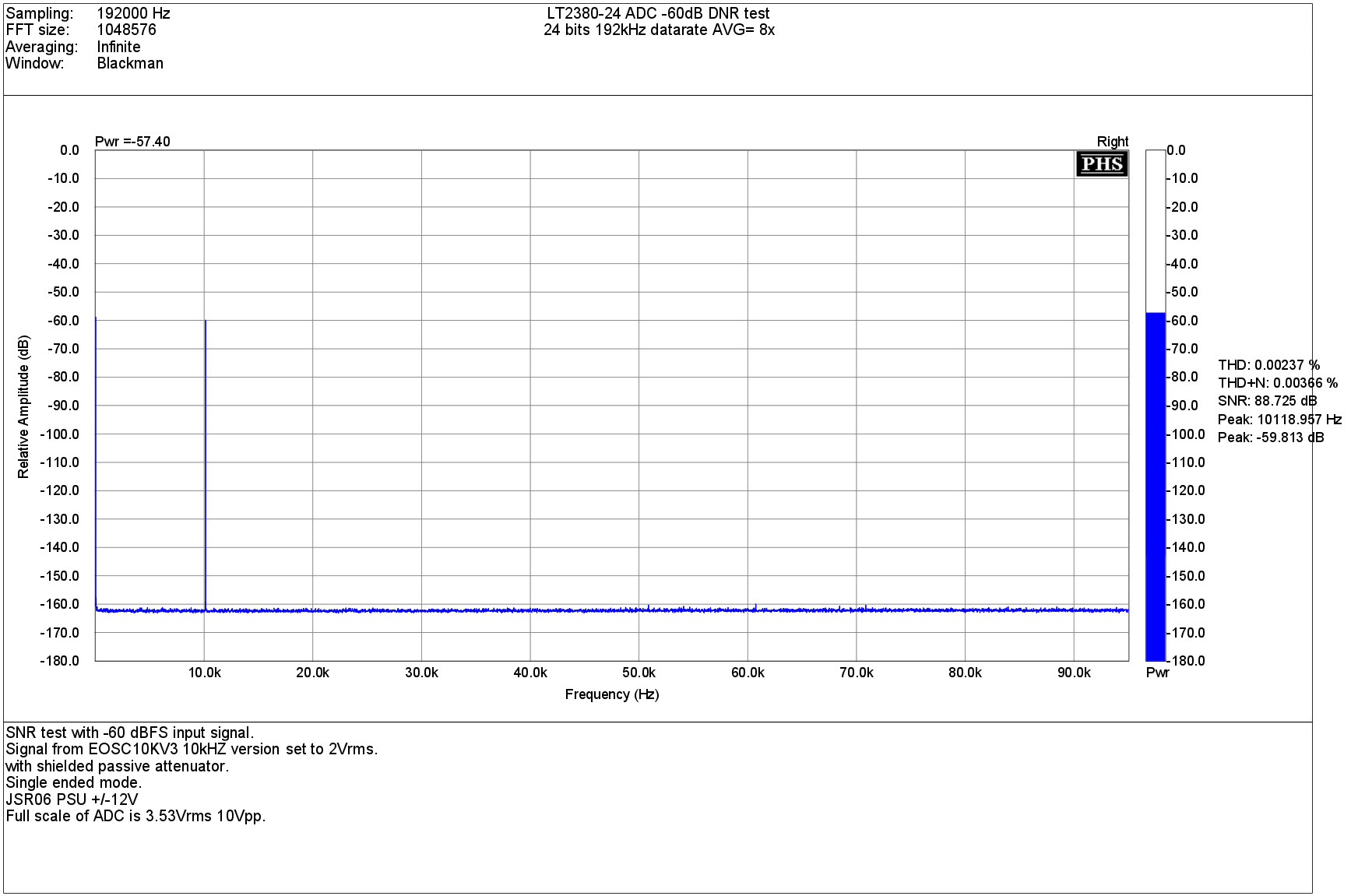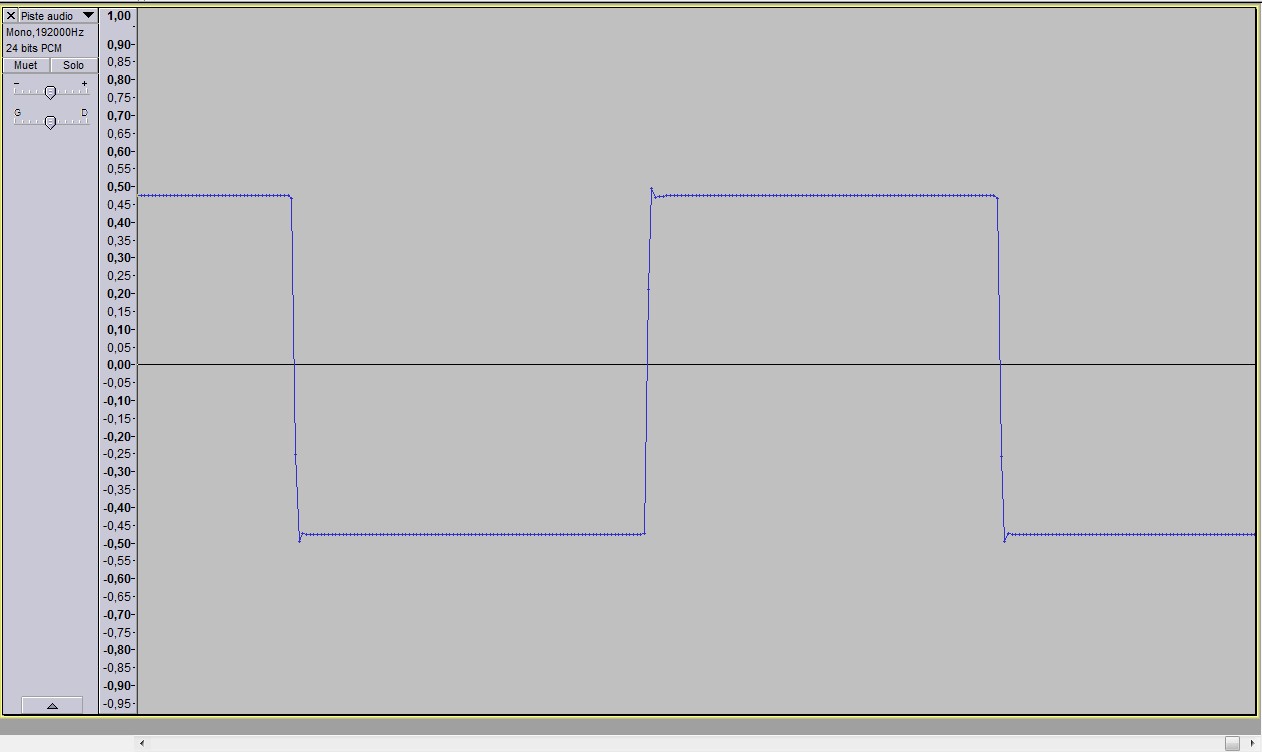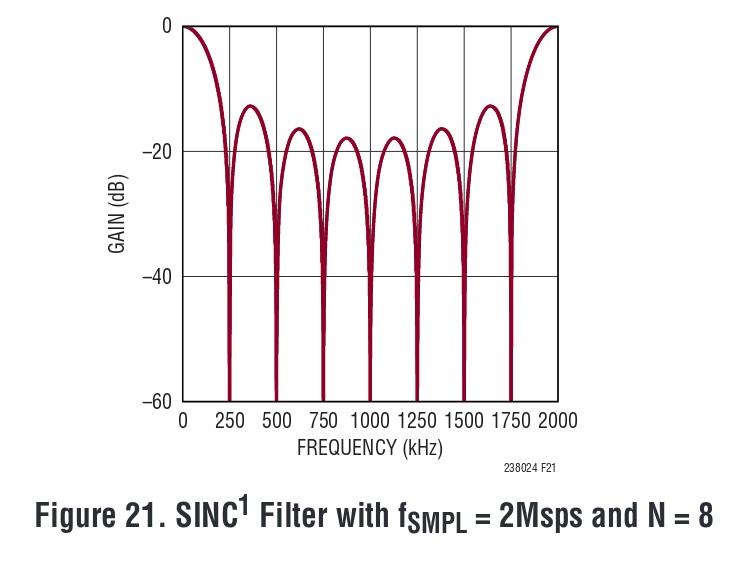Hello Demian,
Yes, DNR test is interesting.
You will find below the FFT result with my EOSC10KV3 10kHz oscillator at 2Vrms
with a passive attenuator between the oscillator and the ADC input.
The attenuator is set to get -60dBFS of ADC.
As you can show, the spectrum is very clean with no idle tone and no THD product visible.
The noise floor level still the same as without input signal.
SNR and THD are really incredible at this level, and i am myself very amazed by all results from this ADC...
LTC2380-24 DNR test, 10kHZ -60dBFS input signal

Of course, all noise source in the near environment are switched off (but the computer is still powered beside it).
The attenuator is fully shielded and all connexions are as small as possible using coaxial connexions.
The chip run at 1.536MHz sampling rate with 8x,16x,32x averaging to get audio sampling rate of
192k, 96k or 48kHz.The averaging is made directly by the IC itself.
I hope that it's more clear . 🙂
Frex
Yes, DNR test is interesting.
You will find below the FFT result with my EOSC10KV3 10kHz oscillator at 2Vrms
with a passive attenuator between the oscillator and the ADC input.
The attenuator is set to get -60dBFS of ADC.
As you can show, the spectrum is very clean with no idle tone and no THD product visible.
The noise floor level still the same as without input signal.
SNR and THD are really incredible at this level, and i am myself very amazed by all results from this ADC...
LTC2380-24 DNR test, 10kHZ -60dBFS input signal

Of course, all noise source in the near environment are switched off (but the computer is still powered beside it).
The attenuator is fully shielded and all connexions are as small as possible using coaxial connexions.
The chip run at 1.536MHz sampling rate with 8x,16x,32x averaging to get audio sampling rate of
192k, 96k or 48kHz.The averaging is made directly by the IC itself.
I hope that it's more clear . 🙂
Frex
That's really impressive results.
When you are ready to make a module available I'm in.
One "issue" running around the audio world today is "dispersion" in the filters. The MQA magic is supposed to be fixing the dispersion effects of the filtering. Maybe a scope like plot of the response to a fast rise square wave or pulse would give some insight. I would expect to see the effect of the antialiasing filter. I'm not sure what this dispersion would look like.
When you are ready to make a module available I'm in.
One "issue" running around the audio world today is "dispersion" in the filters. The MQA magic is supposed to be fixing the dispersion effects of the filtering. Maybe a scope like plot of the response to a fast rise square wave or pulse would give some insight. I would expect to see the effect of the antialiasing filter. I'm not sure what this dispersion would look like.
The moving average in the ADC itself should have minimal impact on the square wave response, no? Or are you talking about an external FIR AA filter that one might implement?
@Frex: Well, I on my part have never seen as clean as spectrum as this. Impressive Frex!
Cheers,
Jesper
Cheers,
Jesper
The spectrum definitely looks very good.
It might be an advantage to use a filter, e.g. implemented in the FPGA, instead of the built in averaging, to get a flat frequency response and a better suppression of the out-of-band signals.
Have you measured the frequency response? I assume that it will roll off somewhat when approaching half the (output) sample rate.
It might be an advantage to use a filter, e.g. implemented in the FPGA, instead of the built in averaging, to get a flat frequency response and a better suppression of the out-of-band signals.
Have you measured the frequency response? I assume that it will roll off somewhat when approaching half the (output) sample rate.
Maybe it is a good strategy for an ADC intended for sound recording is to offer some bandwidth and set filters to say fs/4. This still gives 48 khz at fs 192 - let there be silence between fs/4 and fs/2. Aliasing must be avoided like the plague.
//
//
Last edited:
This is another very interesting part which allows for higher sample rates.
LTC2387-18 - 18-Bit, 15Msps SAR ADC - Linear Technology
LTC2387-18 - 18-Bit, 15Msps SAR ADC - Linear Technology
Well the topic is for audio. For humans probably, so bat territory is maybe OT? 🙂
What a very great dynamic range and low noise could be used for is an attenuator or gain free design. This would make the signal path up to the ADC the simplest possible. It would mean that there where no need of a gain stage and that the whole gain structure of the microphone and the ADC as a system was made to cope with a certain max level and fixed at this configuration. If at a certain recording situation the level only reached to -40 dB doesn't matter - noise and distorsion would still be adequately low.
Possible? Usable? Desirable?
//
What a very great dynamic range and low noise could be used for is an attenuator or gain free design. This would make the signal path up to the ADC the simplest possible. It would mean that there where no need of a gain stage and that the whole gain structure of the microphone and the ADC as a system was made to cope with a certain max level and fixed at this configuration. If at a certain recording situation the level only reached to -40 dB doesn't matter - noise and distorsion would still be adequately low.
Possible? Usable? Desirable?
//
That's quite valid but editing and mixing after recording that way become a major chore for level matching.
Some ADC's from AKM have a flag that tells the system when its close to overload. Some mixing systems use that to automatically turn down the gain.
Some ADC's from AKM have a flag that tells the system when its close to overload. Some mixing systems use that to automatically turn down the gain.
Hello,
Demian, as i already said to TNT by PM, much work is still needed before to get a complete ADC unit.
It would including two channels,high performance front-end, (attenuator ?),
selectable digital filtering, and more things to be defined.
Probably at least a year.
But, be sure that when ready, i will make the design available for everyone
as for my others projects.
About the digital filter response, Chris is right.
The internal moving average filter perform very well in time domain.
You can see below an Audacity screen capture of ADC recorded data.
The ADC input is driven with 5Vpp 1kHz square wave from a RIGOL generator.
Time domain response of 1kHz 5Vpp square wave (SR 192kHz)

Of course, with a FIR brick-wall filter instead of the averaging filtering, the response
will not be same. Anyway, the FPGA code will allow to choose between time domain fidelity
or faster stop-band attenuation, or even others things...
JensH,
My FPGA board ordered at Mouser is delayed and will only arrive in early December.
I'm a little bit impatient to play with...
The averaging filter has not a flat response, i lost about 6dB at 96k for SR=192k.
You can look below the frequency plot response of the internal filter below (from LT datasheet).

Frex
Demian, as i already said to TNT by PM, much work is still needed before to get a complete ADC unit.
It would including two channels,high performance front-end, (attenuator ?),
selectable digital filtering, and more things to be defined.
Probably at least a year.
But, be sure that when ready, i will make the design available for everyone
as for my others projects.
About the digital filter response, Chris is right.
The internal moving average filter perform very well in time domain.
You can see below an Audacity screen capture of ADC recorded data.
The ADC input is driven with 5Vpp 1kHz square wave from a RIGOL generator.
Time domain response of 1kHz 5Vpp square wave (SR 192kHz)

Of course, with a FIR brick-wall filter instead of the averaging filtering, the response
will not be same. Anyway, the FPGA code will allow to choose between time domain fidelity
or faster stop-band attenuation, or even others things...
JensH,
My FPGA board ordered at Mouser is delayed and will only arrive in early December.
I'm a little bit impatient to play with...
The averaging filter has not a flat response, i lost about 6dB at 96k for SR=192k.
You can look below the frequency plot response of the internal filter below (from LT datasheet).

Frex
Well, one who waits for something good.... always waits to long 🙂
But it would be fun to be involved into trying to build a really good recording *system*. This to me would be to create something that took real recording situation into consideration such as; a) acoustical induced vibration (clock jitter), b) dirty mains (battery?), c) long distance to mic (mov ADC close(er) to mic - opto? contradiction to a)), d) mic phantom power etc... more?
//
But it would be fun to be involved into trying to build a really good recording *system*. This to me would be to create something that took real recording situation into consideration such as; a) acoustical induced vibration (clock jitter), b) dirty mains (battery?), c) long distance to mic (mov ADC close(er) to mic - opto? contradiction to a)), d) mic phantom power etc... more?
//
That's really impressive results.
When you are ready to make a module available I'm in.
One "issue" running around the audio world today is "dispersion" in the filters. The MQA magic is supposed to be fixing the dispersion effects of the filtering. Maybe a scope like plot of the response to a fast rise square wave or pulse would give some insight. I would expect to see the effect of the antialiasing filter. I'm not sure what this dispersion would look like.
Do you have a reference? My understanding, which could be incorrect, is that dispersion is limited to filters that are not linear-phase.
Undersampling
And no filtering at all please, as DiAna (that's my distortion analyzer s/w) will be very happy to show harmonics beyond the Nyquist frequency. 🙂
BTW, you are doing a wonderful job!
Cheers, Edmond.
Hello,
[..]
Anyway, the FPGA code will allow to choose between time domain fidelity or faster stop-band attenuation, or even others things...
[...]
Frex
And no filtering at all please, as DiAna (that's my distortion analyzer s/w) will be very happy to show harmonics beyond the Nyquist frequency. 🙂
BTW, you are doing a wonderful job!
Cheers, Edmond.
Do you have a reference? My understanding, which could be incorrect, is that dispersion is limited to filters that are not linear-phase.
All the talk is murky audiophile BS. But dispersion is the underlying buzzword. MQA asserts that most if not all ADC's have a "problem" that they fix with some DSP . There really has not been published info to support this. Here is the MQA patent https://worldwide.espacenet.com/pub...T=D&ND=3&date=20131218&DB=EPODOC&locale=en_EP
Quote supporting my (bs) claim above:
"Our hearing is much more sensitive to timing information than we thought," he continued. "Because of our ingrained sense of survival, human beings are at least five times more sensitive to timing information than to frequency. We can discern time intervals of a few microseconds.
"What works perfectly for instruments doesn't work for digital filters, which smear timing. CD smears timing for 4 milliseconds, which is the equivalent of sound traveling 4 feet. With MQA, we've redesigned the way digital sampling is done. MQA reduces ringing and smearing dramatically, over ten times more than on 24/192 recordings."
Read more at Mytek to Support MQA | Stereophile.com
4 mS is a long time. They are suggesting the the harmonics of a french horn are delayed/advanced by 4 mS. I have not seen anything like that and you would never get a clean transient/square wave from such a system. There are speakers with that much or more dispersion between woofers to tweeters and its not that audible. Similar in many tape systems.
Sorry for the sideways transition but I see nothing in this ADC to suggest an issue.
Sorry for the sideways transition but I see nothing in this ADC to suggest an issue.
"Our hearing is much more sensitive to timing information than we thought," he continued. "Because of our ingrained sense of survival, human beings are at least five times more sensitive to timing information than to frequency. We can discern time intervals of a few microseconds.
"What works perfectly for instruments doesn't work for digital filters, which smear timing. CD smears timing for 4 milliseconds, which is the equivalent of sound traveling 4 feet. With MQA, we've redesigned the way digital sampling is done. MQA reduces ringing and smearing dramatically, over ten times more than on 24/192 recordings."
This looks more like marketing talk, there is no clear statement of what they are technically trying to say. I have seen too many comments about this that border on violating basic information theory.
BTW my comment last week about Audacity and 24 bits was concerning USB cards only I thought that was clear.
Last edited:
- Home
- Design & Build
- Equipment & Tools
- SAR ADC for high performance audio ADC project [LTC2380-24]